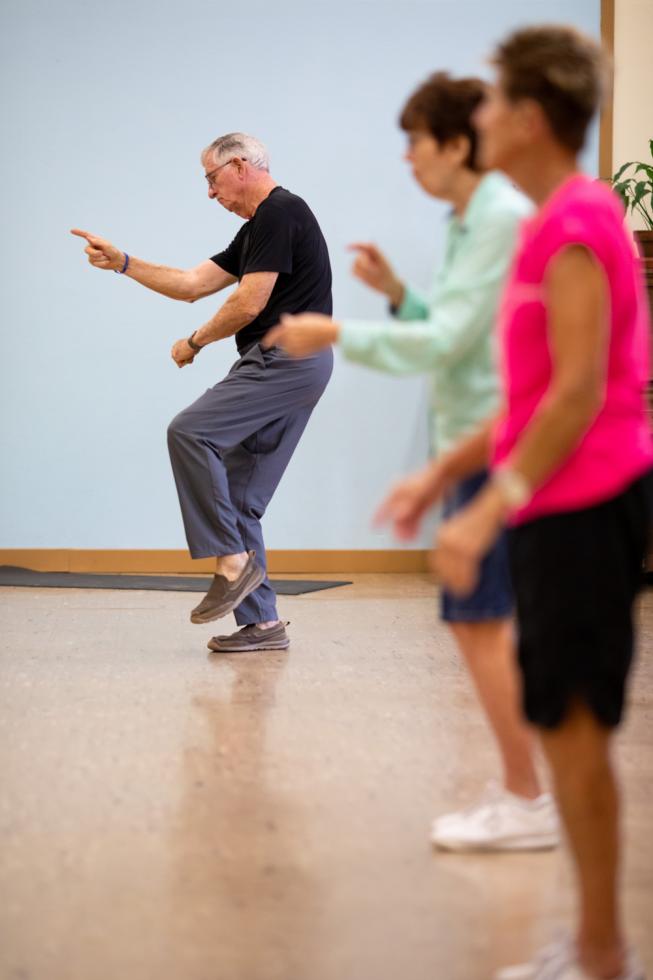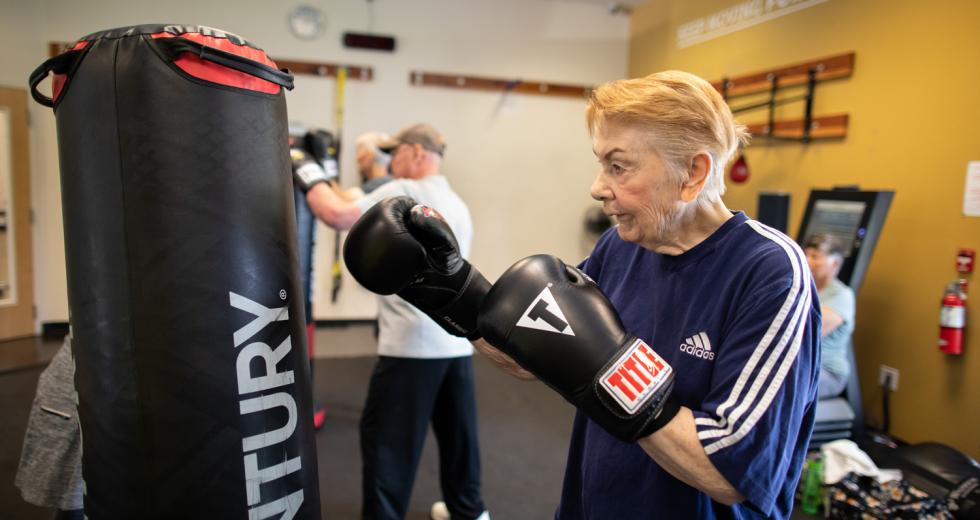Jim Morris, a 78-year-old retired Sacramento Superior Court judge, remembers jogging. It eased his mind after long days in court, listening to criminal cases. He used to jog with friends during lunch, from Southside Park to Miller Park, and alone after work or on weekends along the American River bike trail.
STEP BY STEP
In recent years, health professionals have adopted a more holistic approach to treatment, connecting patients to a range of specialists — neurologists, physical therapists, speech therapists, occupational therapists, dietitians — to customize care and improve overall quality of life.
This approach is at the heart of a proposed project in Natomas. Vibra Healthcare, a Pennsylvania-based company, has plans to build a 50-bed rehabilitation hospital, offering physical, occupational and speech therapies for patients with neurological injuries and diseases, including Parkinson’s disease.
In addition to bikes, treadmills and weight equipment, Michael Long, Vibra’’s president of the rehab division, says the hospital will also have a Bioness Vector, a high-tech harness designed to prevent falls and help patient mobility. Designs also include an outdoor course paved with various surfaces (gravel, grass, bark, etc.) for people to practice walking, Long says.
“The key to any therapy is proactive and purposeful practice,” he says. “If someone says, ‘I’ve got three steps to enter into my home,’ we’ve got to practice that. You don’t want functional level to decrease. You want to stay the same or get better.”
This new hospital is expected to be operational in 2020, complementing Vibra’s long-term acute care hospital in Folsom.
Morris doesn’t do any jogging these days. He was diagnosed with Parkinson’s disease in 2008, and now his legs get stiff and he struggles with balance. But every other Monday afternoon after taking his medication, he goes dancing at Grace Presbyterian Church in the Arden-Arcade area with about a dozen other “PWPs,” as he calls them — people with Parkinson’s. An unofficial offshoot of the international program Dance for PD, this class is a form of physical therapy, where PWPs get down to old-school classics of the 1960s, songs like “I Heard it Through the Grapevine” by Marvin Gaye and “In the Midnight Hour” by Wilson Pickett. Some attendees dance in their seats, some hold the backs of chairs, some get up and do complicated steps. Morris understands exercise is the best way to fight this disease trying to control his body.
“If I wasn’t doing exercise, I would be shriveling up more, hunched over more, have more trouble extending my legs and arms to the extent I can now,” Morris says. “I think that all affects your frame of mind. If you’re keeping this thing at bay, you have to have a positive attitude.”
There is no cure for PD — a chronic, progressive disease that more than 10 million people in the world live with, according to the Parkinson’s Foundation. While there are many medications to temporarily improve symptoms like Morris’ stiffness and balance problems, they do nothing to slow the disease’s progression. That’s why physical therapy is a vital component to any treatment program, as studies increasingly show that exercising multiple times a week could actually help delay progression of symptoms. Programs like Morris’ dance classes offer the added benefit of allowing those living with the disease to bond with others going through the same situation.
“[Patients with PD] need to exercise for the rest of their lives,” says Christine Shade, a physical therapist at Kaiser Permanente in Roseville. “They’re not going to be getting one-on-one training every day, so on other days we need them out in the community exercising. People with Parkinson’s really have power over their disease.”
GET PHYSICAL
Parkinson’s disease is primarily a problem of dopamine, as the feel-good brain chemicals also send signals for movement. In the brains of people with PD, the cells that produce dopamine begin to die, causing stiffness, tremors, gait and balance problems, and other motor and non-motor symptoms.
While medications recruit remaining brain cells to help the body use dopamine more effectively, those meds have a short life in the body — kicking in after about 45 minutes and giving patients a boost for just a few hours before wearing off.
“Meds only help the symptoms, but exercise can slow down the progression of the disease.” Christine Shade, physical therapist, Kaiser Permanente Roseville
But if people with PD exercise within that timeframe, they can take full advantage of the dopamine jolt, according to Shade.
“Meds only help the symptoms, but exercise can slow down the progression of the disease,” Shade says.
Exercise has been an integral part of PD treatment plans since the 1980s. A 2009 study from the Parkinson’s Foundation looked at 10,000 participants in five countries and found that, “Increasing physical activity to at least 2.5 hours a week can slow decline in quality of life.”
The spectrum of symptoms a given patient will experience is wide, just like the range of physical therapy options. Running, biking, boxing, tai chi, yoga, Pilates — activities like these incorporate some measure of stretching, aerobic activity and/or resistance training, which are key ingredients shown to help patients fight against symptoms.
“Early on, people with PD took their [medication] but weren’t encouraged to exercise,” Shade says. “Now with all the great research showing how exercise can slow the progression of PD, especially with intensity of exercise, physical therapists now have changed their treatment strategies.”
To truly be effective for individuals with early-stage PD, the exercise can’t be moderate, according to new research. No strolls around the block or light jogging on weekends. Only high-intensity exercise (between 80-85 percent of a person’s maximum heart rate), like jumping rope three times a week can slow the progression of the disease while improving strength, balance and flexibility, according to studies by Margaret Schenkman, director of the physical therapy program at the University of Colorado’s School of Medicine.
With research like this, Shade says, physical therapists should be “trying to really push the intensity of exercise with their treatments and home programs for their PD patients.”
STEADY ROCKIN’
Jim Morris has maintained an active lifestyle, including biweekly
dance classes, since being diagnosed with Parkinson’s disease a
decade ago.

From Kevin Quinn’s perspective, the greatest power over Parkinson’s is a punch. At his Anytime Fitness gym in Rancho Cordova, Quinn runs an affiliate for Rock Steady Boxing, a nonprofit organization founded in 2006 by Scott C. Newman, a former Indiana prosecutor living with PD. The fitness program uses noncontact boxing training to combat PD symptoms.
Quinn works with 35-40 boxers, ranging in age from 47 to 85. He teaches them strength work (dumbbell squats, kettlebell swings, push ups) and mobility drills. They run around cones and hop across hurdles. They learn how to fall, how to get up and other techniques to improve agility and endurance. And they learn how to box.
“I’ve seen people come into the gym in wheelchairs, and four weeks later, they’re chasing me around, throwing punches,” Quinn says.
It might seem counterintuitive, especially since the late, great Muhammad Ali’s bout with Parkinson’s disease is often attributed to his time in the ring. But the sport demands so much activity from the body and mind that, as a physical therapy exercise, advocates say boxing is a true champ.
“Boxing can help patients with PD improve coordination, dynamic balance, strength and amplitude of their movement,” says Madeleine Smiley, a doctor of physical therapy at UC Davis Health.
“My balance has been getting better. The hits require a lot of footwork, breathwork and balance.” Cathy Kennard, student
After volunteering at the Sacramento Rock Steady Boxing affiliate in 2016, Quinn started his own program, seeing the impact of boxing firsthand on the lives of people with PD.
Take Cathy Kennard, for example. When she first started boxing last Christmas, she came to Quinn’s gym with her caregiver, who held Kennard’s belt in case she fell. Now 84, she boxes three times a week. Her caregiver still comes but doesn’t need to help her up from the floor as Kennard says her strength has improved.
“I had no interest in boxing whatsoever, but it’s mostly balance you’re improving on, and my balance has been getting better,” she says. “The hits require a lot of footwork, breathwork and balance.”
As Quinn sees it, the effect isn’t just physical, but also emotional, as boxing gives people the freedom to express their frustration, pain, rage or any other emotion in a safe environment.
“Just being a human here, no matter what you’re going through, the psychological impact of being able to punch and yell and give it all you’ve got — it’s healing stuff,” he says. “We’re fighting in there. Everybody knows they’re in a fight. We’re all in it together.”
LEAN ON ME
For people with PD, a sense of community can be crucial to improving mental health, especially depression, which affects at least a third of this population. Changes in brain chemistry — including the loss of dopamine and serotonin — correlate to mood disorders, but the root cause is not yet clear, and the research is ongoing.
In communal settings, doctors say, physical therapy unites people with PD in a way that may ease mental suffering by breaking isolation or routines that trigger negative thought patterns.
Marsha Kilian, a registered yoga instructor, uses poses to disrupt those patterns. Working with Sacramento-area people with PD, Kilian understands that yoga improves flexibility, strength and balance, but the biggest benefit is the shift in mental posture.
“More importantly,” Kilian says, “it calms the nervous system, which improves the often overlooked symptoms of anxiety and depression.”
Smiley agrees that physical therapy in a group gives patients a boost in mental health and quality of life. “These sessions get them out of the house and into a safe, positive and social atmosphere,” Smiley says.
The Parkinson Association of Northern California, which will host its annual conference this month, facilitates a network of over 30 support groups. Nancy Kretz, president and board chair of the Association, says there is tremendous impact for those who participate in support groups, exercise classes, dance and singing groups, and other social opportunities because they foster collective learning and camaraderie.
“Sharing goals, lending encouragement and celebrating success together is very uplifting,” Kretz says.
So far, Morris hasn’t been overwhelmed by mental torment, but says that doesn’t mean he’s wholly free from negative thoughts. This is why he goes dancing every other Monday — to ease his mind with others like him in a setting that makes him feel good.
“The rhythm, the beat and the old tunes pick me up and let me forget about the negatives and overcome many movement problems,” he says. “I believe I truly don’t suffer from depression at all … yet. But you never know what tomorrow brings with this damn condition.”



